The Egg Carton Game
 |
About the presenter: Dr. Ellen Bennett Lanouette has worked in the field for over 30 years in public school, university, and private practice settings. She received her bachelor's degree from the University of Texas at Austin, master's degree from California State University- Northridge, and Ph.D. from the University of Colorado at Boulder with an emphasis in stuttering disorders. She has co-authored numerous articles and presented many workshops at the local, state, national, and international level. In 2006, she published a comprehensive textbook focusing on the diagnosis and treatment of stuttering entitled Working with People Who Stutter: A Lifespan Approach. In 2007, she was the recipient of the NSA's Speech Language Pathologist of the Year award. Dr. Bennett Lanouette is the International Cluttering Association membership chair and currently works in the Hillsborough County Public Schools south of Tampa, Florida. |
The Egg Carton Game
by Ellen Bennett Lanouette
from Florida, USA
The Egg Carton Game was created years ago as a tool clinicians can use to engage children in a exciting, unpredictable game. It can be used with various disorders, in particular, cluttering. Cluttering is a dynamic disorder characterized by rapid speech rate and disrupted rhythm. The therapy process should help prepare clients for managing rate through modification strategies. The Egg Carton Game is a structured therapy activity that provides clients with opportunities to change their speech rate through phrasing (also called chunking) and pausing. The following is a description of the game.
Materials Required:
- Egg carton (1 dozen);
- Piece of paper the size of the top of the egg carton, divided into 12 sections with a picture in each section;
- Objects or candy that fit into the sections of the egg carton; and
- Stimulus cards with the response phrases written on them. I have included two examples at the end of this paper. One is for Halloween and the other is for football. I prefer to use theme based activities in therapy.
Steps for Playing the Game:
- The clinician explains the game to the students. The following is a sample of the dialogue for introducing this activity:
Clinician: Today, we are going to play a hide-n-seek game.
During the game, we will practice 'chunking.' We use chunking to manage how much we say at a time. You know that sometimes we try to say too much at once. Kind of like when we are eating a hotdog and take a bite that is too big. It's harder to chew and enjoy. If we take a smaller bite, we can chew easier, slower and enjoy our food. When we clutter, we stuff words in our mouth and the message does not come out clear. So, during this activity, we will 'bite-off' just a bit at a time by using pausing and chunking. Let me show you. I will hide this piece of candy in the egg carton. If I put it in this spot, it is under the 'pumpkin.' If I hide it here, it is under the skeleton. You have to guess where I hide it. If you guess, you can keep the candy and hide the next piece of candy. You will practice saying the question (show the stimulus cards) "Is the candy----pause--- under the ____?" You will use two chunks with a pause between them. If you guess right, I will say "Yes the candy--- is under the ___." If you guess it wrong, I will say: "No the candy --- is not--- under the _____."
- Start the game by making sure everyone can label the pictures on top of the egg carton lid. Then, hide a piece of candy and have the student close their eyes while you do this. Now you are ready to play the game. Give the first person the stimulus cards and tell them to select the picture they want to guess first and then ask their question. Continue the game until someone guesses the correct place. This person gets to hide the next item.
 |
 |
 |
SUBMITTED: February 28, 2010

